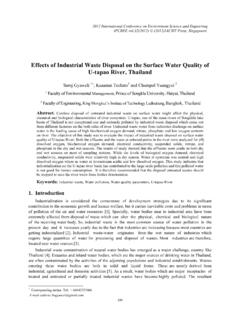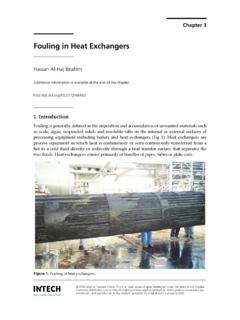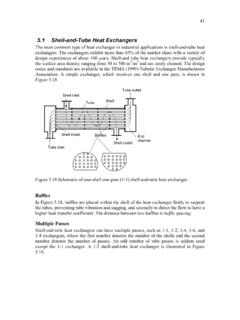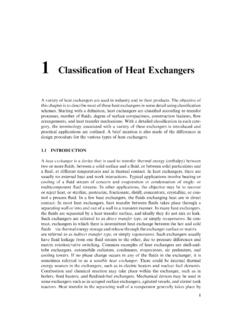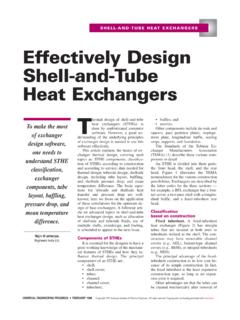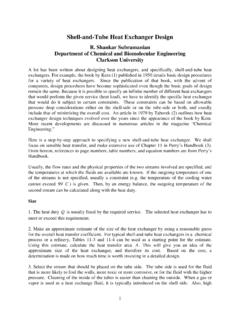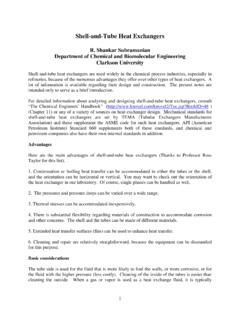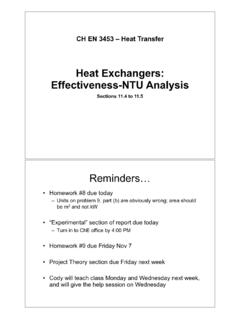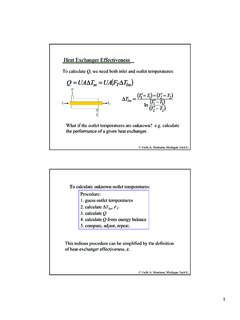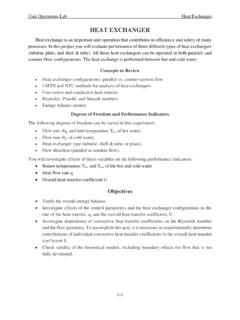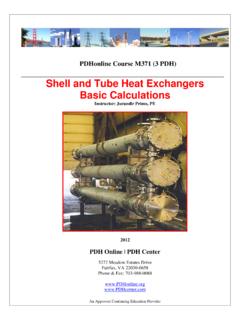Transcription of Factors Affecting Selection of Tubes of Heat Exchanger
1 Factors Affecting Selection of Tubes of heat Exchanger N. Farhami+, A. Bozorgian Islamic Azad University, Mahshahr Branch Abstract. Selecting appropriate materials for heat exchangers are included in the duties of designer and manufacturer engineers of heat exchangers. In this paper, various alloys which are used in producing Tubes of heat exchangers have been studied and the water effects on them have been discussed. The operation and maintenance effects on the Tubes with different alloys and the Factors Affecting heat exchangers design have been also presented. Further, the most appropriate Selection of tube material and sheet have been introduced which is obtained with regard to these Factors . The best and most suitable tube material and sheet as well as fluid optimum speed in the tube or converters shell can be selected through information presented in this article. Keywords: sediment, fluid speed, operating conditions, water quality 1.
2 Introduction Designing a heat Exchanger usually involves three following steps: 1-Thermal design 2- Mechanical Design 3 - Manufacturing Design Thermal design briefly includes calculation of the thermal transfer surface for a certain flow and specific temperatures of cold and warm fluids. While in the mechanical design, exploitation temperature and pressure, corrosion specifications, thermal expansion and thermal pressure are considered. Applying physical characteristics and fluid flow in converter manufacturing design - that includes minimum or optimum cost - selecting appropriate material, sealing, determining converter internal equipment and the optimum of arrangement of Tubes and shells are of the cases considered in Manufacturing Design [1]. This paper includes the special attention to selecting the most appropriate material for producing Tubes and Tubes sheets. 2. How to Select The Most Appropriate Material The following three Factors are considered in selecting the most appropriate tube for heat exchangers: 1-Water quality 2-How to operate and maintain 3 - heat Exchanger design In this study, Tubes made of copper alloy, type 304 and 316 stainless steel, 6 percent molybdenum alloy, Super Ferritics and titanium have been considered.
3 Also, each of the above mentioned three Factors are considered independently and without interaction among the Factors . Since the unsuccessful and unexpected function of the tube in the heat Exchanger can be followed by the effects of these three Factors on the tube, therefore, these three Factors will be studied in detail. + Corresponding author. Tel.: + 98 916 354 4582; fax: + 98 652 232 7070. E-mail address: 2232011 International Conference on Chemistry and Chemical Process IPCBEE (2011) (2011) IACSIT Press, Singapore 3. Water Quality The Factors considered in water quality include purity, chloride level, dissolved oxygen and sulfide level, residual chlorine manganese and level, PH, temperature and capability of creating its sediment. In table (1) water contents and the drawbacks created by these contents are shown. Water Chloride Calcium Ions, magnesium, sodium, iron and other ions are soluble in water since do not deposit, their concentration will be increased in water boiler coolers.
4 According to the amount of water Chloride, various stainless steel alloys are used. Type 354 stainless steel is resistant against corrosion of water with content of 200 PPm chlorides, while Type 316 stainless steel is resistant against up to 1000 PPm chloride content. percent molybdenum alloy is resistant against water containing 2000 PPm to 3000 PPm chloride. Both percent molybdenum alloy and duplex (a new type of stainless steel) has been applied to sea water, containing 2000 PPm chloride, but corrosion has been seen beneath the sedimentary layer on the tube body. 6 percent molybdenum alloy, Super freak and titanium are well resistant against salty water. Oxygen and Sulfate Soluble oxygen in water causes corrosion in the converter Tubes . Sodium sulfites or corrosion preventive substances are added to the water, to reduce the amount of oxygen in it. Sulfates also produce calcium sulfate sediment by Calcium in water which is involved in creating corrosion.
5 Tubes , made of copper alloy and stainless steel, do not act well in waters containing Oxygen of three to four PPm. Copper alloy is not resistant in dirty waters whose oxygen is constantly used for corrosion and sulphate is also present. Tubes made of stainless steel and titanium excellent material have been applied successfully to these waters. Free Chlorine Chlorine gas is dissolved in water and forms hypochlorite ion and hypochlorite acid which play role corrosion. Chlorine is usually added to the water to make it suitable. Copper - nickel and stainless steel alloys are both containing against water. heat In the warm waters, protective film on the copper alloys is formed as quickly as five minutes at temperature of 60 degrees F. But, it happens slowly at cold water. Such a phenomenon is gradually forming on Stainless steel Tubes . PH In water containing air and less than 5 PH, Tubes will be corroded and thinned quickly, because protective film would not be easily formed on the Tubes made of copper alloy.
6 Copper alloy shows good resistance against the water whose air has been egresses and its PH is also low. Tubes made of copper - nickel or stainless steel alloy at high PH are preferred to admiral Tubes (71 percent copper, 28 percent brass and 1 percent tin) or Tubes made of aluminium-brass alloy which get corroded at alkaline PH. stainless steel Tubes act well at less than 5 and above 9 PH. Manganese Manganese and iron are of the substances that Cause water discoloration during deposition. Type 304 Stainless steel Tubes are not resistant in fresh water containing significant amount of manganese. However, copper alloy and more resistant alloys have acted almost well in such waters. Sediment or Mass Absorption Tubes sediment or Mass absorption level has an important effect on thermal transfer in heat exchangers. Creating sediment in internal surface of the tube not only reduces thermal transfer and the flow section level, but also adds to the resistance against thermal transfer.
7 This resistance is so called Fouling factor. It is often difficult to determine the value of this parameter and it would be guessed empirically. Fouling Factor value for shell and tube heat exchangers is given in Table (2) for several fluid samples. 224 Table 1-Water contents contents resultant problems Hardness main Sedimentary materials are in thermal converters and boilers Free and mineral acids corrosion bicarbonate Oxide Corrosion occurrence especially in condensers and steam lines PH shows acidity or alkalinity level of water Sulfate ion It combines with calcium and makes calcium sulfate sediment Chloride ion Increases water corrosion Na It combines with OH and causes corrosion Silicate It causes deposition in boilers and cooler systems Oxygen It involves in deposition occurence in boilers Hydrogen sulfide It causes bad smell (rotten eggs) and corrosion Table 2- Fouling factor amount a few fluid samples Fluid R, W/m2 River water 3000-12000 Sea water 1000-3000 Cooler column water 3000-6000 City water (soft) 3000-5000 City water (hard) 1000-2000 Steam condensate 1500-5000 Steam (no oil) 4000-10000 Steam (with oil trace) 2000-5000 Industrial air and gases 5000-10000 Furnace gases 2000-5000 Organic Liquid- vapor and light hydrocarbons 5000 Heavy hydrocarbons 5000 4.
8 How to Operate and Maintain Operation procedure and having specific and determined program for heat exchangers maintenance are of the important Factors having an important effect on converter longevity. Although both Factors have much influence on product cost, on the other hand, selecting appropriate alloys also leads to maintenance cost reduction. How to Operate Stop time of the stagnant water in the converter Tubes is of the cases which should be taken into account during operation. If heat Exchanger is supposed to be stopped for two three days for some reasons, its water would better be replaced with pump once a day and if it is supposed to be out of service more than one week, its water must be completely evacuated. The evacuation and water replacement operation has an important influence in Tubes corrosion prevention. Because when the water is inside the converter, it would get deposited and provide the appropriate environment for the growth of bacteria.
9 Thus, no converter should ever be left with stagnant water. Keeping water containing or even moist Converter leads to its corrosion. Cleaning Schedule heat Exchanger Tubes cleaning schedule depends on the fluid type applied to the tube. The grosser the fluid, the sooner it gets deposited and also creates defects in the operation of the unit and operation of the converter. Thus, Converters must be opened continually and Scheduled, their water be drained and be brushed so that the sediments and fripperies would be removed in the internal surface of Tubes . In this case, corrosion phenomenon will be prevented and Thermal load of the converter will be increased as well. Converter which has water containing high biological materials and sediments are should be cleaned weekly. Because if the microorganism are settled or not exited, they would cause corrosion, even in stainless steel. Although tube cleaning seems beneficial, on the other side, it should be noted that warm water produces a protective film on the surface of the Tubes and mechanical cleaning of them too much can cause loss of this protective film.
10 Thus the critical optimum period should be considered for tube cleaning. Tubes made of copper alloy or stainless steel should be cleaned monthly or once every three months for most waters. If thermal load is not so critical, mechanical cleaning can be postponed to annually and sometimes for longer period. However, it should be acted carefully. Because if sediment remains in the Tubes more than three months corrosion occurs under it. 5. Designing heat Exchanger The main Factors Affecting the performance heat Exchanger Tubes include: fluid velocity, tube diameter, converter tube shape (U or cross shape), converter layout order (horizontal or vertical), and Venting valve, material of tube sheet and channel and location order of input channel. Fluid Velocity High speeds increase the thermal transfer coefficient, but they are associated with pressure drop instead. Speed should be so high that could prevent from particles deposition on the one hand and on the other hand; it should not be so high that it would cause tube corrosion itself.




